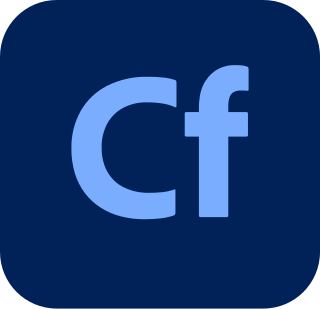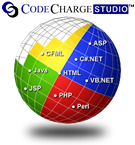Zope is a family of free and open-source web application servers written in Python, and their associated online community. Zope stands for "Z Object Publishing Environment", and was the first system using the now common object publishing methodology for the Web. Zope has been called a Python killer app, an application that helped put Python in the spotlight.
An application server is a server that hosts applications or software that delivers a business application through a communication protocol. For a typical web application, the application server sits behind the web servers.

WebObjects is a discontinued Java web application server and a server-based web application framework originally developed by NeXT Software, Inc.

Adobe ColdFusion is a commercial rapid web-application development computing platform created by J. J. Allaire in 1995. ColdFusion was originally designed to make it easier to connect simple HTML pages to a database. By version 2 (1996) it had become a full platform that included an IDE in addition to a full scripting language.
Web development is the work involved in developing a website for the Internet or an intranet. Web development can range from developing a simple single static page of plain text to complex web applications, electronic businesses, and social network services. A more comprehensive list of tasks to which Web development commonly refers, may include Web engineering, Web design, Web content development, client liaison, client-side/server-side scripting, Web server and network security configuration, and e-commerce development.
ColdFusion Markup Language, more commonly known as CFML, is a scripting language for web development that runs on the Java virtual machine (JVM), the .NET framework, and Google App Engine. Several commercial and free and open-source software implementations of CFML engines are available, including Adobe ColdFusion, Lucee, New Atlanta BlueDragon, Railo, Open BlueDragon, and other CFML server engines.
BlueDragon is a ColdFusion Markup Language (CFML) engine comparable to Adobe Systems's ColdFusion. It is licensed and distributed by New Atlanta from TagServlet Ltd based in Scotland. BlueDragon is also distributed and supported by BEA Systems on their Oracle WebLogic Server server platform.
In computing, Oracle Application Development Framework, usually called Oracle ADF, provides a Java framework for building enterprise applications. It provides visual and declarative approaches to Java EE development. It supports rapid application development based on ready-to-use design patterns, metadata-driven and visual tools.
Apache Beehive is a discontinued Java Application Framework that was designed to simplify the development of Java EE-based applications. It makes use of various open-source projects at Apache such as XMLBeans. Apache Beehive uses Java 5, including JSR-175, a facility for annotating fields, methods, and classes so that they can be treated in special ways by runtime tools. It builds on the framework developed for BEA Systems Web logic Workshop for its 8.1 series. BEA later decided to donate the code to Apache.

Apache Tapestry is an open-source component-oriented Java web application framework conceptually similar to JavaServer Faces and Apache Wicket. Tapestry was created by Howard Lewis Ship, and was adopted by the Apache Software Foundation as a top-level project in 2006.
FuseDocs is a program definition language created by Hal Helms in the late 1990s.
Railo Server, commonly referred to as Railo, is open source software which implements the general-purpose CFML server-side scripting language, often used to create dynamic websites, web applications and intranet systems. CFML is a dynamic language supporting multiple programming paradigms and runs on the Java virtual machine (JVM).
Seasar2 is an open-source application framework similar to the Spring Framework (Java). Initially, it was developed for the Java platform by Yasuo Higa, but .NET and PHP platforms are currently supported as well. Seasar2 has a large base of Japanese users, but there is a steady increase of non-Japanese users since English support was announced at the JavaOne 2005 Tokyo conference.
ColdSpring is a web application framework for the ColdFusion application programming language, based on the Java Spring Framework. It was originally created by Dave Ross and Chris Scott. The framework provides dependency injection, inversion of control and aspect-oriented programming design pattern capabilities in an effort to make the configuration and dependencies of ColdFusion components (CFCs) easier to manage.
The Spring Framework is an application framework and inversion of control container for the Java platform. The framework's core features can be used by any Java application, but there are extensions for building web applications on top of the Java EE platform. The framework does not impose any specific programming model.. The framework has become popular in the Java community as an addition to the Enterprise JavaBeans (EJB) model. The Spring Framework is free and open source software.
Apache Camel is an open source framework for message-oriented middleware with a rule-based routing and mediation engine that provides a Java object-based implementation of the Enterprise Integration Patterns using an application programming interface to configure routing and mediation rules.
ZK is an open-source Ajax Web application framework, written in Java, that enables creation of graphical user interfaces for Web applications with little required programming knowledge.

CodeCharge Studio is a rapid application development (RAD) and integrated development environment (IDE) for creating database-driven web applications. It is a code generator and templating engine that separates the presentation layer from the coding layer, with the aim of allowing designers and programmers to work cohesively in a web application.

ColdBox is a free, open-source, conventions-based, modular web application framework intended for building enterprise applications with ColdFusion (CFML) using a Hierarchical MVC approach.
Lucee is an open source implementation of a lightweight dynamically-typed scripting language for the Java virtual machine (JVM). The language is used for rapid development of web applications that compile directly to Java bytecode, and is compatible with contemporary CFML script and tag language variants, and provides configurable support for legacy CFML.




